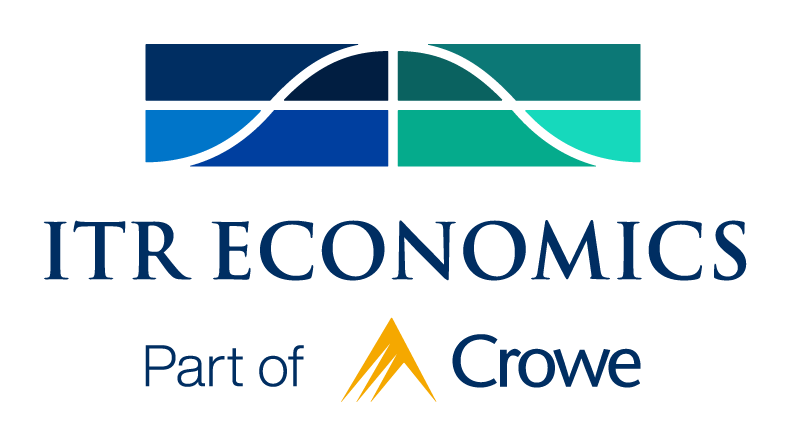September 16, 2024
- Home
- portfolio
- TrendsTalk
- September 16, 2024
INFLATION IMPACT ON PRODUCERS AND CONSUMERS
This week on TrendsTalk, ITR Economist Taylor St. Germain takes a deep dive into inflation data from both producer and consumer perspectives. With higher inflation expected later in the decade, how can you take advantage of the lower borrowing costs in 2024 and 2025? Tune in to learn more!

MEET YOUR HOST
Taylor St. Germain
As an experienced economist, Taylor St. Germain provides consulting services for small businesses, trade associations, and Fortune 500 companies across a spectrum of industries. His dynamic personality and extensive knowledge of economic trends and their business relevance are highly valued by clients and colleagues alike.
“Join me on the TrendsTalk podcast to explore the world of economics. Episodes offer insightful discussion and expert interviews. We cover relevant economic concepts in an accessible way. Whether you are a curious layperson or an industry professional, TrendsTalk is your go-to source for thought-provoking analysis and a deeper understanding of the economic forces shaping our world.”
The below transcript is a literal translation of the podcast audio that has been machine generated by Notta.
Taylor St. Germain:
Hi everyone, my name is Taylor St. Germain with ITR Economics and welcome to this episode of TrendsTalk. We at ITR are your apolitical and unbiased source of economic intelligence. We’ve got a lot to talk about today and I wanted to talk about inflation, both sides of the inflation equation, both the producer side and the consumer side.
I hope that you’ll think about these two metrics independently of one another. And the reason I say that is they’re at different points in the business cycle and there’s different expectations as we move forward. And so I wanted to start off with the producer side of inflation. Now when I say producer inflation, I’m referencing the U.S. Producer Price Index, it’s one of our Trends Report series. And the definition of a series like this is average selling prices of finished goods and services here in the U.S. economy. Now this type of index is often more representative of the pricing environment for businesses as it is just that. It’s how much does it cost to produce our goods and services?
And as we talk with clients, it’s been very challenging to raise prices over the course of the last year, year and a half. In even some cases, having to lower prices can be the result of some lower material cost. It can be the results of some higher inventory levels. There’s a number of factors that can go into this. But we have seen the Producer Price Index generally slow down and even at times fall below the zero line.
I like to quote the month-over-month numbers when we’re looking at the Producer Price Index. And what we’ve seen from that month-over-month growth rate, that 1/12 growth rate, is we did spend a little bit of time below the zero line in 2023 and that indicates some downside pressure on prices. When we look at where the data is on a year-over-year basis, we are up only 0.8% year-over-year. And as we look at where we’ve been, that’s a big change from the about 15% up we saw back in 2022. So I think you can see what I’m illustrating here is Producer Price inflation has slowed down and even on a month-over-month basis, we’ve seen some Producer Price deflation, not just disinflation.
Now as we move forward though, we see that the Producer Price Index is bouncing off a low point on an annualized basis. The 1/12 growth rate is positive and we’re at a again positive 0.8% on an annualized basis. As we move forward, our year-over-year forecast for Producer Prices is 1% up in 2024, a positive 1%, positive 2.6% in 2025 and a positive 3.4% in 2026. So what you’re hearing me say is there’s a gradual year-over-year increase in Producer Price inflation.
So what does that mean? Well that means you will likely be facing some higher costs of materials and of labor and of higher costs when it comes to producing your goods and services. It also means there’s likely going to be some opportunity to raise price as well as we look at especially ’25 and ’26 as this economy heats up.
So for a lot of businesses, that’s good news, right? Which is that we’re finally going to be able to raise some prices again. But again, please note that you’ll be facing some increased costs yourself. So having that pricing strategy in place to offset some of those increases is going to be important as we look at ’25 and ’26. That’s the producer side. Again, it’s a Trends Report series, so please go into that financial section of our Trends Report and get some more information about that data set.
But I wanted to now focus on the consumer side of inflation, much more, I should say, in a different spot in the cycle. If we look at the CPI, the Consumer Price Index, that too is slowing down, but it isn’t slowing down as quickly as what we saw in producer prices. We have disinflation, which is just a slowing rate of rise in inflation. We do not have deflation on the consumer side of things, like we saw a little bit in the PPI back in 2023. So what are our expectations as we move forward for consumer inflation?
Well, consumer inflation on a year-over-year basis is sitting at 3.3%, and we do expect that growth rate to slow down to 3% by the end of this year. So CPI slowing down, another 0.3% by the end of 2024, and slowing even further into 2025, finishing 2025 at 2.8%. Those are two very important points because with that CPI continuing to slow in ’24 and ’25, that’s coloring our thoughts that we’re going to see lower interest rates in ’24 and ’25. And again, head over to FedWatch to learn more about what Brian, our chief economist, is saying about the Fed interest rates in inflation. But my quick overview there is CPI slowing down in ’24 and ’25 means lower interest rates coming our way in ’24 and ’25.
Now, we have leading indicators that do tell us with a high degree of accuracy that that slowdown in the CPI is going to be the case. One indicator I like to call out is the US M2 Money Supply. We look at that on a deflated basis. And if you look at the money supply, 1/12 growth rate, month-over-month growth rate, it actually is a 24-month leading indicator to consumer inflation. And the good news is that over the course of the last 24 months or so, we have seen that money supply slow down and even contract, which tells us, again, with a high degree of accuracy, that consumer inflation will indeed slow down.
Now, it’s very important we acknowledge this slower inflation in ’24 and ’25 and thus the lower interest rates. So we can take advantage of those lower borrowing costs and be investing because one thing we are starting to see is that there’s signs that consumer inflation is going to pick back up in 2026. And one of the leading indicators that tells us some inflation can be coming out there in 2026 with the CPI is that we are issuing more treasuries than we ever have before.
And you might be saying, why do we issue treasuries? Well, it’s one of the ways that we fund fiscal spending here in this country. And so to see the big pickup in treasury issuances tells us this slowdown in the CPI in ’24 and ’25 is temporary. And as we move into 2026, we need to be a little bit more concerned about inflation picking back up.
So all in all, consumer inflation slowing down this year and next, it’ll be a welcoming site, especially as for those folks looking for lower interest rates. But note that as we get a little further down the line in 2026, we’re already seeing signs the next round of inflation will be forming. Let’s make those moves in ’24 and ’25, invest in our businesses, take advantage of these lower borrowing costs, and then have a strategy in place for the second half of this decade to start to take on higher inflation, which we’re already seeing some signs for.
I certainly hope you found this information helpful. Again, the CPI and PPI forecasts that I referenced here today are both Trends Report series. So you can find more information on a monthly basis by subscribing to our Trends Report.
Also wanted to note, you’ll see some new faces on TrendsTalk coming here over the course of the next few weeks. I’m not going anywhere, but my wife and I are expecting our first child here in the next few weeks, which of course we’re so happy, thrilled, and excited about. So you will see some new faces filling in for me occasionally. I’ll be popping in and out, but all good news, all good things going on here at ITR, and of course something I’m very excited about here personally.
I hope you enjoyed this edition of TrendsTalk. Please remember to like and subscribe to TrendsTalk wherever you listen to your podcasts, and I’ll look forward to seeing and talking with you all here in the near future. Take care for now.





